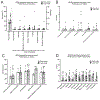Psychometric outcome measures in beta-propeller protein-associated neurodegeneration (BPAN)
- PMID: 35878504
- PMCID: PMC9613602
- DOI: 10.1016/j.ymgme.2022.07.009
Psychometric outcome measures in beta-propeller protein-associated neurodegeneration (BPAN)
Abstract
Background: Beta-propeller protein-associated neurodegeneration (BPAN) is a rare neurodegenerative disorder characterized by iron accumulation in the brain with spectrum of neurodevelopmental and movement phenotypes. In anticipation of future clinical trials and to inform clinical care, there is an unmet need to capture the phenotypic diversity of this rare disorder and better define disease subtypes.
Methods: A total of 27 individuals with BPAN were included in our natural history study, from which traditional outcome measures were obtained in 18 subjects. Demographic and diagnostic information, along with acquisition of basic developmental skills and overall neurologic severity were extracted from the medical records. Functional outcome measures were administered at the time of the evaluation or applied retrospectively at the last clinical encounter for patients who were not able to travel for in person. Based on age and functional level, the following assessments were administered: Leiter-3, Gross Motor Function Measure (GMFM)-66 Item Sets, Vineland-3, and Peabody-2.
Results: Overall, cognitive function was more impaired compared to gross motor function. Onset of symptoms of BPAN within the first 6 months of life was associated with decreased gain of ambulation and gain of spoken language (ambulation: log-rank test p = 0.0015; gain of first word: p = 0.0015). There was no difference in age at seizure onset by age at initial symptom onset (p = 0.8823). Collection of prospective outcome measures was limited by attention and behavior in our patient population, reinforcing the complexity of phenotype assessment and inadequacy of available standardized tests. Overall, gross motor and adaptive behavior assessments were better able to capture the dynamic range of function across the BPAN population than the fine motor and non-verbal cognitive tests. Floor effects were noted across outcome measures in a subset of individuals for cognitive and adaptive behavior tests.
Conclusion: Our data suggest the distinct phenotypes of BPAN: a severe, early onset form and an attenuated form with higher cognitive capabilities. Early age at onset was a key factor in predicting future neurologic impairment.
Keywords: BPAN; Clinical assessment tools; NBIA; WDR45.
Copyright © 2022. Published by Elsevier Inc.
Conflict of interest statement
Conflict of interest disclosures
FG has no conflict of interest to disclose.
NT: BridgeBio Pharma-Consultant.
LAA is a consultant for Takeda, Biogen, and Orchard Therapeutics.
Figures




References
-
- Wan H, Wang Q, Chen X, Zeng Q, Shao Y, Fang H, Liao X, Li HS, Liu MG, Xu TL, Diao M, Li D, Meng B, Tang B, Zhang Z, Liao L, WDR45 contributes to neurodegeneration through regulation of ER homeostasis and neuronal death, Autophagy. (2019) 1–17, Epub 2019/06/18 10.1080/15548627.2019.1630224. - DOI - PMC - PubMed
-
- Adang LA, Pizzino A, Malhotra A, Dubbs H, Williams C, Sherbini O, Anttonen AK, Lesca G, Linnankivi T, Laurencin C, Milh M, Perrine C, Schaaf CP, Poulat AL, Ville D, Hagelstrom T, Perry DL, Taft RJ, Goldstein A, Vossough A, Helbig I, Vanderver A, Phenotypic and imaging spectrum associated with WDR45, Pediatr. Neurol 109 (2020) 56–62, Epub 2020/05/11 10.1016/j.pediatrneurol.2020.03.005. - DOI - PMC - PubMed
Publication types
MeSH terms
Substances
Grants and funding
LinkOut - more resources
Full Text Sources

